Harry Potter and the kanohi of horcruxes.
But hasn’t it’s predictions always been wrong?
If it hasn’t been correct, then is it really a possible future? It seems more like the Olisi can rule out futures.
If it has, than I might have cracked it. What the Olisi might be doing, is looking into the future of multiple futures, each of which is going to happen, just to multiple dimensions.
Example. Say you Tahu has three choices, Eat a pizza, eat a burger, or starve. The Olisi can show him what would happen if he eats a pizza, a burger, or starve, but it doesn’t know which future will happen, making each one possible for there dimension. Whichever two Tahu doesn’t choose, will happen in alternate dimensions.
So, when the Mohtrek pulls from the past, all it means is that one of the futures of a dimension will include Bitil pulling himself from that moment. It would then allow the Olisi to see other futures where Bitil does not pull himself from that moment.
Another thing, if the issue with this whole dimension thing, is that Bitil can’t be simultaneously in two dimensions, then he simply isn’t.
At the point a Bitil is pulled, an alternate dimension is made, making an additional Bitil now in a new dimension called B. Bitil B is pulled over to the dimension his summoner is in, and after the summoner is done with him, Bitil B is sent back to his new dimension.
If the next issue would be “Well then why can’t Bitil summon himself from other dimensions all the time?” To that, I say that Bitil must know the general state of the Bitil he’s pulling. He can’t pull a Bitil from another dimension whenever he feels like it, because he doesn’t know anything about them. (Location, appearance, etc.) The reason he can pull Bitil B in, is because at the point where a new dimension is created, Bitil B is 100% similar to the Bitil on the dimension from which his just branched
I really hope this all checks out
Ah, but that’s the definition of the mask - alternate realities and possible futures, futures that have the capability to occur in the universe they are viewed in.
Just like the Mohtrek brings past versions of the user, the Olisi sees not impossible futures, but possible ones. We can’t say the Mohtrek’s definition must be followed and then say the Olisi is open to interpretation; if one description is canon, so is the other.
All except the original Bitil dying. If Bitil B dies, he’s from an alternate dimension at the time of summoning - how then does his death kill Bitil A? Theoretically, that situation wouldn’t have any affect on main universe Bitil.
As well, the Mohtrek only creates another universe when a past Bitil dies and jeopardizes the safely of the universe, per Greg quote:
if your past self gets damaged, what happens is an alternate future gets created in which your present day self is similarly damaged. It does not affect your “main universe” self.
Since Greg later confirmed this is how the Mohtrek operates, that means an alternate universe is created only when the user dies and an irreconcilable paradox comes about. That means no alternate universes for bruises or cuts - the ones Bitil received in the story? Those were from a future him.
So where does this leave us? Half of my headcanons on it have been proven wrong, and as far as I can tell it still doesn’t make much sense.
But doesn’t that quote confirm the fact that alternate dimensions are created for injuries? In order for a past Bitil to be injured without it affecting “main universe” Bitil, the injured past Bitil gets thrown into a dimension with a different time line, one where the injuries have lasting effects.
Main universe Bitil repeatedly suffered from bruises and injuries suffered from his being called into the future. If an alternate universe was called each time, it wouldn’t happen repeatedly to him.
I think this is something we can all agree on.
But every time he’s injured, and therefore put into a new dimension, a “new” future is created for him, one where his future self will undoubtedly call upon him for aid, injuring him again, and that process would keep going.
I’m kind of confused about what you mean though, so I may be completely off
I mean… yeah, the Possible Futures shown by the Olisi will happen in alternate dimensions, simply because Greg has stated that there is an alternate universe for every single possibility.
However, that’s not the mask’s power: the mask simply shows futures that are possible in this timeline. It doesn’t guarantee that the future will or will not come to pass in this reality, simply that it could have.
According to my understanding, this is correct (assuming that Tahu has some degree of control over the “flipping points” of the possible futures he sees).
I agree with this part of your theory, since that’s more or less what I’ve been saying from the start, but I don’t see what it has to do with the Olisi.
No, that’s the exact opposite of what Greg said. In the very quote you posted, he specifically said that alternate universes are caused by “damage”, and that your main universe self is unaffected; therefore, any damage that Bitil suddenly receives must have been from an alternate future self summoning him into the future of that alternate dimension.
Yes it would. Take this example:
Bitil A in Timeline A uses his mask, summoning a version of himself that gets injured. This creates Timeline B and Bitil B, who is now randomly injured. Then, some time later, Bitil B uses his mask, and the summoned past self is injured again. This creates Timeline C, branching from Timeline B. This timeline features Bitil C, who has now experienced damage when Timeline B was created, and when Timeline C was created. Repeat for a ton of alternate dimensions, with each Bitil having a 50/50 chance of taking damage from each use of the mask that they are involved in.
What this means is that, somewhere in the multiverse, there is a “prime Bitil” who has never experienced random damage, and that there is at one Bitil who has taken random damage every single time their own alternate future selves used the mask.
It’s like what @Krelikan said:
EDIT:
I meant to address this as well:
It seems to me like “destiny”, as it refers to Mata Nui’s wishes and the timeline of the Matoran Universe, is set by the Great Beings and can be changed, while “destiny”, as it refers to the future of the natural universe, is what we have been discussing, and cannot be changed.
Here’s a fun idea I just had: Could two versions of a Mohtrek-user from different realities that diverged from the use of a Mohtrek call each other’s past versions from that divergence point?
(I currently think the answer is no, but allow me to elaborate anyways)
For example:
Say that Version A of Bitil summons a past version of himself. According to what was discussed in the topic above, this would result in the creation of an alternate timeline at that exact point in time, and anything that happened to the summoned version would only affect the version of Bitil in the newly-created timeline (Version B), leaving Version A unaffected.
If Version B were to later summon a past version of himself from that exact same point in time, could he summon Version A of his past self?
If this were to happen, both versions would only be affected by what happens in the alternate timeline, both effectively diverging from each other simultaneously, rather than having a “new” timeline diverge off of a timeline where Bitil is unaffected.
As I said above, despite this being my idea, I don’t think it would work. The primary reason I say so is that I simply think it would be impossible to pick a past self from the exact same instant in the first place; even if Bitil associated the exact point in time with a specific memory, the formation of that memory would still cover an effectively-infinite number of “divergable instances”, with no way to isolate any specific one.
However, let’s say that Bitil is able to perform some technique that allows him to pull a past self from a specific instant in time; in that case, I’m still not entirely convinced that it would be possible for two versions to summon each other, but I’m also not entirely convinced that it’s not, and I’m kind of leaning towards it being possible.
The reason I lean towards it being possible is because of what I said above:
Is there really any difference between one timeline diverging from another vs. two timelines diverging from each other?
What are anyone else’s thoughts on this? Is it possible for two instances of a Mohtrek-wearing being to summon each other?
First, let’s discuss Mohtrek users across timelines in a more broad sense.
Say you have a timeline that diverges into two branches at some point in time, and in this timeline, there exists a Mohtrek user (this is the situation you’re presenting, just reworded). For time prior to the point of divergence, both versions of the Mohtrek user share that time as their past, so both can call upon their past selves from that time. However, version A cannot call upon a past version of B after the point of divergence, because that is not version A’s past.
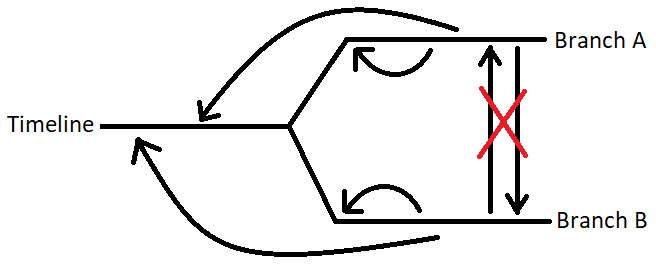
This is pretty straight forward, but still worth explaining, plus it helps to be able to visualize what’s going on.
Now, I’m a little confused by your wording. Are you asking whether a Mohtrek user could summon their past self from exactly the point of divergence, or if version A and and version B can simultaneously summon their past self from the point of divergence? If the latter, that’s not specific to that point; it could happen for any point in time before that as well. As to what would happen, I’m not sure. If the former, I could see it going either way (no pun intended).
Neither.
For starters, I fully agree with your conclusions for the two scenarios you presented; I have no doubt in my mind that both Version A and Version B could summon themselves from that point, and I also have no doubt that they could do it simultaneously, since “simultaneously” doesn’t really exist here, given that we’re talking about a single point in time; that point in time could be summoned any number of times by any number of versions that diverged from the future of that timeline.
My question is whether the two versions can summon each other.
We all know how it goes; Version A summons a past self, creating Version B, which takes all the damage from the summoning into Timeline A. From Version B’s perspective, he suddenly generates damage. Then, if Version B uses his mask in the future, he creates Version C, which takes all the damage from being into Timeline B, again seeming to spontaneously generate the damage.
What I’m asking is if it’s possible for Version A to summon Version B and to have Version B summon Version A.
What that would mean is that Version A would spontaneously generate the damage that occurred in the future of Timeline B, Version B would spontaneously generate the damage that occurred in the future of Timeline A, and there would be no version left undamaged.
On an unrelated note, what you said above got me thinking on another scenario:
As you said, both versions could pull the same past version of themselves from any moment on their shared timelines. Would the damage stack in that case? Or even if the same version pulls the exact same instance of themselves multiple times?
Say that Version A summons a past version of themselves, creating Version B, who spontaneously generates damage in his own timeline. Then, some time later in Timeline A, Version A summons again himself from the exact same time (assuming that such a thing is even possible), creating Version C. Would Version C also have the damage that Version B received, since Version B also exists in that exact instance?
Either I’m interpreting this wrong, or I have some issues with what I’m getting out of this.
I’m not really clear on how this spontaneous damage thing would work, but I’d assume that this wouldn’t work, as Bitil can’t pull an alternate self to the present. When he sends back version B, he can never contact that version again (unless maybe he goes to that specific dimension). I would say pulling from other dimensions is strictly impossible. Although these dimensions may theoretically have a point of contact, control is still lost, similarly to hot holding hands with someone does not give you control over their muscles.
The issue I have with this idea though, is that if version B is sent to his new dimension, and is gravely injured, until he’s healed, he could only summon injured selves. Meaning, after being sent to a new dimension, Bitils summoning power could take a heavy nerf temporarily.
He doesn’t pull the past self from an entirely different dimension, he pulls the past self from the exact moment where the dimensions diverge from each other. It’s definitely a bit of a gray area, but that has to be the case for the mask to work as it does (in the sense that the damage received by the summoned version only affects the alternate version).
I do, however, agree with this, and it answers the second question I brought up above:
I think this is correct in the sense that, when Bitil summons a past instance of himself, he’s summoning the version of the instance that corresponds to himself, no matter how many other versions are diverging from that point. So, no matter how many times he summons an instance from an exact point in time, it’ll always just create a new version of his own version of himself, rather than piggybacking on an existing version.
Now that I think about it, I think this answers my original question as well; if the Mohtrek always makes a copy of the user’s version of themselves at the dimensional split (rather than copying a different version at the split), it would mean that, since Version B is by definition different from Version A, Version B couldn’t summon Version A, and would instead summon a version of himself that has the same spontaneous injuries he received at the divergence point.
That’s why I was also wrong about this:
Yes, there is a difference: in the former, only one version is spontaneously damaged and the other is unchanged, while in the latter both version are changed with no “prime” version existing.
So, I would argue that no, two versions cannot summon each other, though I’d be interested in other takes on the matter to see if there’s any aspect I missed.
Alternate Take:
I’m not convinced that there is a difference; if the versions are able to summon each other, they are each their own “prime”/unchanged version, while the other version is the “diverged”/changed version.
If Version A randomly gets injuries due to fighting in the future of Timeline B, and then summons the past version of himself from that moment who then gets injured in Timeline A, then the “prime” version is the version that has the B-set of injuries, since those injuries would have happened whether or not he used the mask. Then, the “diverged” version is the version with the A-set of injuries that got returned to the diverged dimension (Version B)
Conversely, from Version B’s perspective, the “prime” version is the version with the A-set of random injuries, while the “diverged” version is the version with the B-set of injuries.
Ultimately, where it gets confusing is the fact that each diverged dimension is caused by the use of the Mohtrek, so for the two versions to be able to summon the other, they would each have to be summoned before and after the other. This initially seems impossible, but given that we’re dealing with a single instant in time (which cannot have anything “before” or “after” in it), and the Mohtrek has already shown that effect can chronologically come before cause, is it really impossible? The two universes would basically simultaneously generate each other.
For starters, I fully agree with your conclusions for the two scenarios you presented; I have no doubt in my mind that both Version A and Version B could summon themselves from that point, and I also have no doubt that they could do it simultaneously, since “simultaneously” doesn’t really exist here, given that we’re talking about a single point in time; that point in time could be summoned any number of times by any number of versions that diverged from the future of that timeline.
Yeah, and you don’t even need branching timelines to show this. The same version of the Mohtrek user at different points in time could summon his past self from the same point time; it’s the same situation. All that would happen is that multiple branches would be created at that singular point in time from where the past version was summoned from.
My question is whether the two versions can summon each other .
We all know how it goes; Version A summons a past self, creating Version B, which takes all the damage from the summoning into Timeline A. From Version B’s perspective, he suddenly generates damage. Then, if Version B uses his mask in the future, he creates Version C, which takes all the damage from being into Timeline B, again seeming to spontaneously generate the damage.
What I’m asking is if it’s possible for Version A to summon Version B and to have Version B summon Version A.
What that would mean is that Version A would spontaneously generate the damage that occurred in the future of Timeline B, Version B would spontaneously generate the damage that occurred in the future of Timeline A, and there would be no version left undamaged.
Could you maybe draw a picture, cause I’m still not understanding? How it reads to me is that you’re asking whether the Mohtrek can hop timelines, when it’s already been established that it can’t.
He doesn’t pull the past self from an entirely different dimension, he pulls the past self from the exact moment where the dimensions diverge from each other. It’s definitely a bit of a gray area, but that has to be the case for the mask to work as it does (in the sense that the damage received by the summoned version only affects the alternate version).
And you affirm that here, which only makes me even more confused. How does summoning exactly from the point of divergence change that?
Could you maybe draw a picture, cause I’m still not understanding?
First, here’s how we currently understand the mask to work:
Here’s Makuta Bitil, going about his day on the timeline:
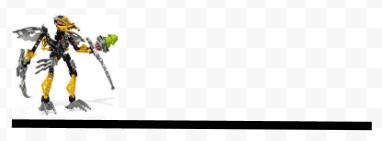
Now, at some point in the future, he encounters an enemy:
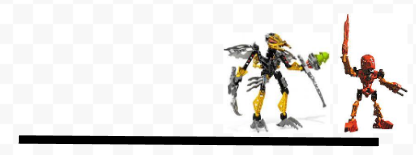
So he chooses to use his mask, summoning a past version of himself from the indicated point on the timeline, who then receives some form of damage or other change (represented by grayscale Bitil):

Then, when the mask is deactivated, Gray Bitil is sent back to the alternate timeline that diverged from the use of the mask:
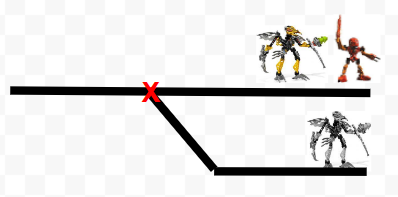
Now, at some unspecified point in the future, Gray Bitil encounters an enemy of his own:

So Gray Bitil uses his mask and summons a past version of himself from the same indicated spot on the timeline, who again takes a new form of damage:
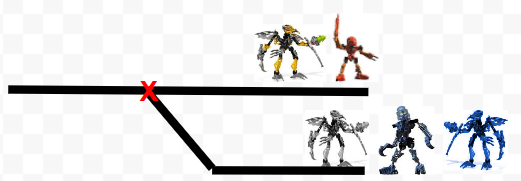
Then, when the mask is shut off, Blue Bitil is once again sent back to his own timeline that diverged from the exact same spot:

So now there are three Bitils: The original version that took no random damage (Version A), the version that took random damage from being summoned into Timeline A (Version B), and the version that took random damage from being summoned into Timeline B (Version C). The important part is that here, it is clear that Version B was “created” by Version A, and Version C was “created” by Version B, and the timeline (including the past) looks like this:
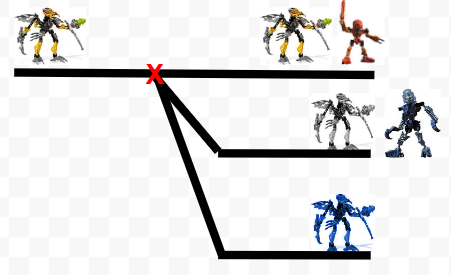
So that’s how we know the mask works. The scenaio I’m asking about, though, goes like this:
Once again, Bitil is going about his day on the timeline:

But then, he suddenly gains random damage from being summoned into the future and being returned to the diverging dimension:
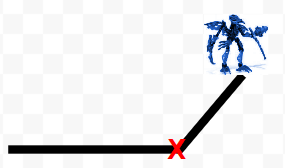
Then, once again, he encounters an enemy:
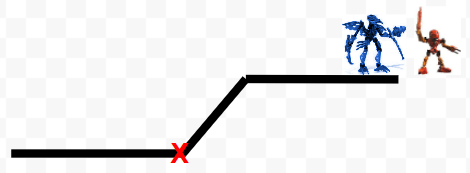
Then, as in the first example, he summons a past self, this time from the exact divergence point. The summoned self would have all the same damage that the current version had when he diverged (since the mask can only summon the past instances of the version of the user):

But then in the fight, he gains additional damage:

Then, when the mask is deactivated, the summoned self is sent back to the diverged timeline:
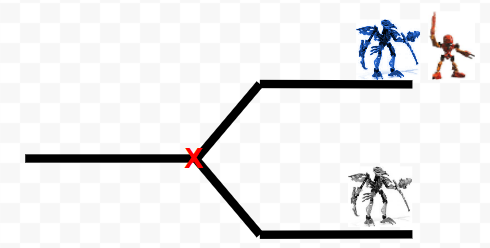
Then, the diverged version encounters an enemy and summons a past version of himself (from the exact same divergence point):

But once again, this self is damaged in the fight:
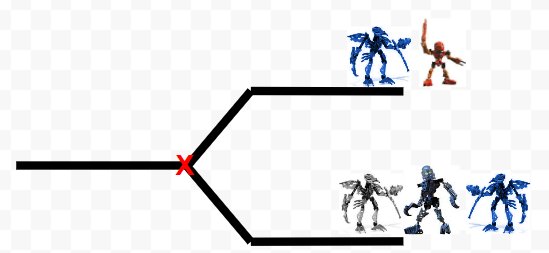
And then when the mask is deactivated, the past self is sent back to his own timeline. However (and this is the crux of the whole thing), I am proposing that it is this battle that caused the initial random damage to the version in the first place, leaving the final timeline looking like this:
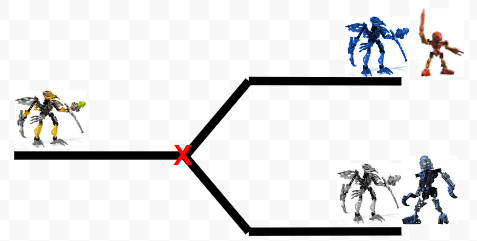
Here, despite the fact that, as before, there were two uses of the Mohtrek in different universes, there are only 2 versions: Version A, which has random damage from Timeline B, and Version B, which has random damage from Timeline A, with no undamaged version of Bitil.
Here, it is less clear who “created” who; Version A (with damage from Timeline B) was “created” by the summoning in Timeline B, but Timeline B was also “created” by Version A in the first place.
Since we’re talking about these divergences happening in a single instant in time with no concept of “before” or “after”, is such a paradox possible?
This doesn’t seem right to me
place, leaving the final timeline looking like this:
Would this not just toss version B into a timeline separate from the original?
You kind of just left out the original time line altogether here
Would this not just toss version B into a timeline separate from the original?
That’s what I’m not sure about. I definitely could happen, but I could make arguments for or against that always being the case.
You kind of just left out the original time line altogether here
How do you define the “original” timeline? A timeline diverges when something different happens, neither one of those is “more right” than the other.
It’s definitely tempting to say that the timeline with the non-randomly-injured Bitil is the “original”, but the lack of something happening is just as impactful as it happening.
It’s definitely tempting to say that the timeline with the non-randomly-injured Bitil is the “original”, but the lack of something happening is just as impactful as it happening.
I would say that the non-injured Bitil is the original, as he was the catalyst that made it all happen.
I think you’d have to make a strong argument as to why version B is dropped into the “original” timeline.
Right now, where I’m at with the functionality of this mask, is that Bitils are sent into alternate timelines, at the instant they were taken from. There’s no way to “stack damage”, as the summoned Bitils are always put into a branching timeline. The injured Bitil can’t cause damage stacking, for the same reason that you can’t pull from a different timeline.
Although these timelines are in contact with each other, the injured Bitil is in a separate branch, making it impossible to summon
I would say that the non-injured Bitil is the original, as he was the catalyst that made it all happen.
The way I’m presenting it, both versions are the catalyst that “caused” the other diverging timeline.
Right now, where I’m at with the functionality of this mask, is that Bitils are sent into alternate timelines, at the instant they were taken from. There’s no way to “stack damage”, as the summoned Bitils are always put into a branching timeline. The injured Bitil can’t cause damage stacking, for the same reason that you can’t pull from a different timeline.
I definitely agree with what you’ve said here; if Version A summons a past self who then gets injured and sent to Timeline B, Version A couldn’t resummon Version B and add to his injuries.
The closest we’d get to “damage stacking” would be if Version B eventually summoned his injured self and then that version got injured further and was sent back to another new timeline (Timeline C), but that would be a new version altogether.
When I type it all out like this, the situation that I just called impossible seems very similar to the situation we’re discussing above with the two versions summoning each other, but they still seem just different enough that the initial situation might not be impossible.
EDIT: I think I just figured out why you’re right, and it’s probably impossible for two versions to summon each other. Let’s look at the diagram I posted above:
Version A is on top (blue), and Version B is on the bottom (gray).
Version B diverged from Version A when he received injuries in the future of Timeline A; by definition, Version B has, from the point of divergence, had the injuries obtained in Timeline A. Therefore, when Version B summons his past self from the point of divergence, it will have the Timeline A injuries. Then, when the past self gets injured in Timeline B, he will have both sets of injuries. If both versions could summon each other and Version A is the version that diverged from Version B’s use of the Mohtrek, that would mean that Version A would also have both sets of injuries.
Then, when Version A summons his past self, both he and his past self would already have the injuries that the past self is about to receive in battle, and this isn’t something that can be waved away by weird time effects; once the past self is summoned, time works normally. He couldn’t have the wounds and other effects from a fight at the start of the fight.
The only way this could work would be if the summoned past self could be sent back in the exact same state that they were in when they were summoned, but that’s impossible; even if there’s no injuries, the progress of time can’t be reversed.